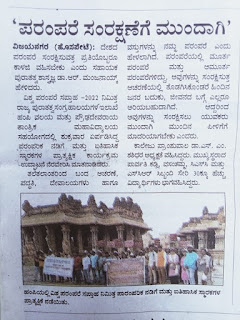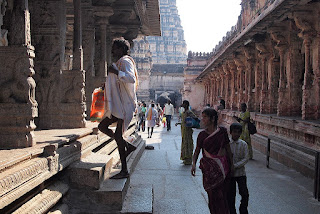The Heritage Walk
Module 2
The Heritage Walk
The Heritage walk was held on special week called world heritage week on 25th of November.
All CSE department staff was cooperated and made the event successful
Forestry, Museums and heritage department joined with us and made it as a memorable one which has been published in newspapers
Virupaksha Temple is located in Hampi in the Vijayanagara district of Karnataka, India. It is part of the Group of Monuments at Hampi, designated as a UNESCO World Heritage Site. The temple is dedicated to Sri Virupaksha, a form of Shiva. The temple was built by Lakkan Dandesha, a nayaka (chieftain) under the ruler Deva Raya II also known as Prauda Deva Raya of the Vijayanagara Empire.[1]
Hampi, capital of the Vijayanagara empire, sits on the banks of the Tungabhadra River (Pampa hole/Pampa river). Virupaksha Temple is the main center of pilgrimage (ತೀರ್ಥಯಾತ್ರೆ )at Hampi, and had been considered the most sacred sanctuary over the centuries. It is intact among the surrounding ruins and is still used in worship . The temple is dedicated to Lord Shiva, known here as Virupaksha/Pampapathi, as the consort of the local goddess Pampadevi who is associated with the Tungabhadra River. There is also a Virupakshini Amma temple (mother goddess) in a village called Nalagamapalle, Chittoor district, Andhra Pradesh, approximately 100 km from Tirupati.
History
The temple's history is uninterrupted from about the 7th century. The Virupaksha-Pampa sanctuary existed well before the Vijayanagara capital was located here. Inscriptions referring to Shiva date back to the 9th and 10th centuries. What started as a small shrine grew into a large complex under the Vijayanagara rulers. Evidence indicates there were additions made to the temple in the late Chalukyan and Hoysala periods, though most of the temple buildings are attributed to the Vijayanagara period. The huge temple building was built by Lakkana Dandesha, a chieftain under the ruler Deva Raya II of the Vijayanagara Empire.[1]
Ceiling Paintings in the Virupaksha date to fourteenth and sixteenth century. The religious sect of Virupaksha-Pampa did not end with the destruction of the city in 1565. Worship there has persisted throughout the years. At the beginning of the 19th century there were major renovations and additions, which included restoring some of the broken towers of the north and east gopura.
This temple is the only well preserved and maintained temple in Hampi until date; the other numerous temples in Hampi were destroyed and ruined by the Brahmani sultanates.
STONE CHARIOT
History of the Chariot
The chariot was built by King Krishnadevaraya of the Vijayanagara Empire during the 16th century, who got fascinated with the Konark Sun temple chariot while fighting a battle in Odissa. The chariot is meant to represent the beauty and artistic perfection of the Empire. An interesting folklore emanates from the Hampi chariot as villagers believe that the world would come to a halt when the chariot moves from its place. It has come to have a sacrosanct presence and is internationally recognized as a world heritage site even by the UNESCO.
QUEENS BATH
History of Queen’s Bath, Hampi
The Queen’s Bath is believed to be constructed by Achyuta Raya for the women of the royal family of Vijayanagara. Though named as the Queen’s Bath, it was in all probability used as the private bathing chamber of the king and his queens. It is also believed that the lavish bath was a royal pleasure complex. This belief is due to the location of the bath, which is outside the Royal Enclosure.
LOTUS MAHAL
Architecture of the Lotus Mahal, Hampi
As the name given to the palace is because of the shape it resembles. The balcony and the passages covered with a dome that looks like an opened lotus bud. The central dome is also carved as a lotus bud. The curves of the palace are given an Islamic touch while the multi-layered roof design is moreover related to Indo style of buildings. The style and designs is an inquisitive blend of Islamic and Indian way of architecture.
HAMPI BAZAAR
History of the Hampi Bazaar
The Hampi Bazaar was once the Center of flourishing trade. It was a well-planned market area. The series of pavilions had an organized structure. Some of the pavilions were two stories. It also had the residences of many rich and important people of that era. It was a market that catered to the demands of the rich people as well as the general masses.
Also known as Virupaksha Bazaar, this street is located in font of the Virupaksha temple . About a kilometer long, the east end of the temple ends at the foothill of the Matanga Hill . Both sides of the street are lined with a series of old pavilions, some of them are two storied. These structures were once part of a thriving market and residence of the nobles.
Towards the west end (towards Virupaksha temple) the pavilions are now encroached and made into shops, restaurants and the likes making the street narrower. Poor villagers have made the eastern section into their homes. It's interesting the houses of the rich merchants and nobles of the empire are now being occupied by one of the poorest.
MATANGA HILLS
History of Matanga Hill
Conclusion
The Heritage walk through hampi gave an experience of walking in ancient times. The history of hampi as many unbelievable facts which drops our jaw. All sculptures have their own history and different ways architecture. This activity too connected us for social responsibility, which gave us a responsibility to save our tradition and heritage of our country. Our active staff members explained everything with a great excitement.
We all together had a great historical day followed by delicious lunch. We all served each other. The day spent well


















Comments
Post a Comment